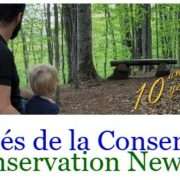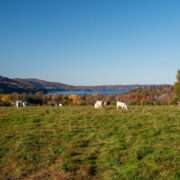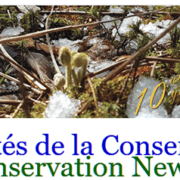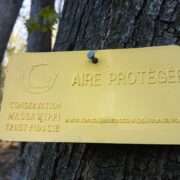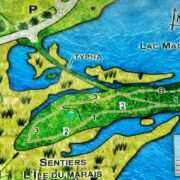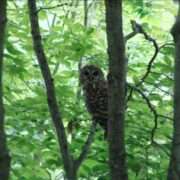View our August newsletter on Mailchimp
Archive for year: 2021
Hamnett Hill is one of the newer members of the Massawippi Foundation board, joining in 2020. In speaking with Hamnett, we discovered that it was his love of the region, the environment, and food that brought him to the table.
He is a relative newcomer to the valley, buying a family property a mere 10 years ago (unlike our founding board member Tom Wilcox whose family has been part of the scene for six generations). Hamnett had cousins in Katevale (Sainte-Catherine-de-Hatley) with an amazing view of the lake and spent many weekends with them. Later on in life, when he and his father started looking for a property that the extended family could enjoy, he knew the Townships generally, and Lake Massawippi specifically, was where he wanted to find a property. It took two years until he finally settled on a spot with a direct view of the green mountains on the west side of the lake, and coincidentally the bulk of land protected by the foundation. He heard about the Foundation through his uncle, Jake Eberts and mutual friends, answered a call from Tom regarding strategic communications and within a short time joined the board contributing his strategic, marketing, and digital know-how to the team.
Hamnett has been described as a serial entrepreneur, operator, and investor who has built and scaled early-stage technology companies for decades. He is currently on several boards including Goodfood Market, Canada’s largest online grocer, and founded the edō Foundation and edō Captial, an organization devoted to increasing awareness and education about sustainable food issues, and investing in and supporting entrepreneurs building businesses to address them.
‘Serendipity’ was the word he used commenting on how closely the evolution of the Foundation’s vision and mission over the next 10 years to to include farming and food production aligns with his personal interests and passion.
Coincidence or synchronicity?
It seems there is an undercurrent of discussion and actions surrounding the way we need to change our ways of producing food in order to improve the way we use natural resources.
Over the last 5 years – and understanding of how much the way we eat and what we eat impacts the world has gone from a niche group of passionate academics, farmers and activists to the mainstream. People everywhere are realizing, in the words of Michael Pollan, that ‘eating is an agricultural, political, and environmental act’ “Eyes are opening, we are rapidly reaching a tipping point in many parts of the world”, says Hamnett. “Business, entrepreneurs, and communities everywhere are beginning to embrace the alignment of demand for sustainable food choices and their sustainable production and distribution – to create new food system economics that enable them to thrive – while protecting and nurturing the environment for future generations“.
For the Massawippi valley, it can mean clean water and green spaces but it can also mean becoming an economic engine that could enable the region to further establish itself as a sustainable, green, agricultural and food center.”
Stay tuned for future newsletters that will reveal the Massawippi Foundation’s vision of the next ten years.

View our July newsletter on Mailchimp
View our June newsletter on Mailchimp
https://mailchi.mp/23e675f4b580/blue-bird-of-happiness?e=2671b2c399#English
The A.G.M. was successfully held via videoconference on June 19th
Documents from the meeting:
Canton de Hatley, June 9, 2021–Massawippi Conservation Trust (MCT) is pleased to announce the acquisition of a new property to be protected in perpetuity in the Massawippi valley. The project is the fruit of a three–year collaboration with three siblings, who fulfilled their parents’ conservation dream by selling their forested and ecologically rich 154 hectares (390 acres) to the MCT in August of 2019.
The Massawippi Foundation and the Massawippi Conservation Trust are two charitable organizations that are respectively responsible for the funding and management of large, protected areas in the watershed of the Massawippi valley.
“After several years of negotiations with the Eberts family, the Trust was able to acquire the second largest parcel of land under our stewardship,” explains Margot Heyerhoff, President of the Fondation Massawippi Foundation (FMF). “The addition of this property will enable us to preserve these pristine forests and ecologically important marshlands. The Foundation (FMF) and Trust (MCT) will also be building a new trail network on the sector which will be appreciated by the users of our trail system. We thank thefamily for their visionary collaboration,” she adds.
Along–time resident of the region and a lover of nature,Jake Eberts was a Canadian Oscar–winning film producer, executive, and financier who purchased the land in 1990.
“Our family roots in this area began with our grandparents, Toppy and Ted Eberts, who purchased a farmhouse on a small plot of land in the town of Katevale (now Sainte–Catherine–de–Hatley) in 1966,” tell the three Ebert children, Alexander, David,and Lindsay. “Our father, Jake, fell in love with the property and bought it from his parents in 1990, and inspired by his time spent in nature as a young boy, continued to add land around the original farmhouse in order toprotect it and enhance its natural state.”
In 2011, Mr. Eberts became one of the founding trustees of the FMF and began considering the possibility of one day perpetually protecting his land. However, he became ill shortly thereafter, passing away in 2012. Conversations to perpetually protect the land continued with his widow, Fiona Eberts, until her unexpected death in 2014. Their three children recently decided to complete their parents’ conservation aspirations for the land through an arrangement with the MCT which includes the part–sale of the land combined with a part donation of 3.25 hectares (8 acres).
“It is with great pleasure that our family was able to complete a long–held dream of our late parents, Jake and Fiona,to transfer a part of our much–beloved family land to the Massawippi Conservation Trust to be protected and appreciated by future generations. Our family would like to acknowledge our contribution to the land,and we recognize and deeply appreciate the Abenaki historic connection to this place,”add the children.
PROTECTING ESSENTIAL HABITATS FOR SPECIES AT RISK
Named “Property # 9” by the MCT, the newly acquired land is home to several varieties of amphibians, birds, and vegetation of interest, all of which will benefit from the protection and conservation of the territory.
As part of their ecological assessment, Appalachian Corridor biologists found streams that provide quality habitat for two species of salamander that are in a precarious status, the Northern Dusky Salamander and the Spring Salamander. The Northern Dusky Salamander is likely to be designated as threatened or vulnerable in Quebec while the Spring salamander is already designated as vulnerable.
With respect to vegetation communities found on the property,there are mainly deciduous woodlands, particularly sugar maple stands, as well as several species vulnerable to harvesting, such as Northern Maidenhair Fern, Two–leaved Toothwort and Ostrich Fern. The land is also home to the Butternut, which is likely to be designated as threatened or vulnerable in Quebec and endangered in Canada, and the Appalachian Sedge which is a rare species.
In terms of bird species, the property’s large interior forests are deemed critical to maintaining populations of forest birds such as the Eastern Wood–Pewee, a species designated as of special concern in Canada.
“The moment our biologists set foot on the property, we recognized the great ecological richness of this environment for its many species and its tremendous relevance in improving the water quality of Lake Massawippi,” explains Mélanie Lelièvre, Executive Director for Appalachian Corridor. “At a regional scale, the protection of the Eberts land supports our efforts to create a wide natural ecological corridor enabling wildlife movements in the landscape and adapting to changes in their movements caused by climate change. We are grateful for the efforts led by MCT and salute the family’s commitment to honoring their parents’ legacy. It is an honour to be involved in this project and to have contributed to its realization,” she adds.
With this recent acquisition, the MCT increases the protected land under its stewardship to close to 485 hectares (1,200 acres) in the Massawippi watershed area where it has been working actively for the past ten years to conserve land in perpetuity adjacent to Lake Massawippi.Appalachian Corridor brings the privately held protected land on its territory of action to 15 062 hectares (37 219 acres). The MCT has been an affiliate member of Appalachian Corridor since 2011.
ESSENTIAL FINANCIAL SUPPORT TO CREATE A GROWING NETWORK OF PERPETUALLY PROTECTED LAND
This project was made possible by generous private donations collected by the Massawippi Foundation and the Massawippi Conservation Trust(MCT). The Government of Quebec also provided support through the Nature Conservancy of Canada’s Project Together for Nature (PEPN), to which the Ministry of the Environment and the Fight against Climate Change has provided $15 million in financial assistance.
“The protection of natural areas, particularly those located on private lands in southern Quebec,help to enhance Quebec’s network of protected areas and also help to ensure the survival of many species at risk,” tells Benoit Charette, Minister of the Environment and the Fight Against Climate Change, Minister Responsible for the Fight Against Racism and Minister Responsible for the Laval Region. “In fact, some of these species were found on the territory part of this conservation project. I am proud to have helped to preserve the habitats for these species and to contribute to their survival thanks to the funding allocated to the Massawippi Trust, the Massawippi Foundation and Appalachian Corridor. Congratulations to the organizations involved in this wonderful project,”he concludes.
Appalachian Corridor received government funding which was provided by this program to grant MCT complimentary technical expertise for the ecological assessment process for the realisation of this project.
ABOUT MASSAWIPPI CONSERVATION TRUST (MCT)
The Massawippi Conservation Trust (MCT) is a registered charitable land trust founded in 2011 whose purpose is to conserve the natural state of the land adjacent to Lake Massawippi and its tributaries and to provide stewardship services for that land in perpetuity. The primary source of funds for the MCT comes via the Fondation Massawippi Foundation (FMF). The MCT protects land by acquisition through purchase or donation; establishing easements or servitudes on land; helping landowners understand the ecological and tax benefits of limiting the types of activities permitted on their land; helping landowners understand the potentially disastrous effect of over–development on the overall well–being of the Massawippi watershed. www.massawippi.org
APPALACHIAN CORRIDOR
Appalachian Corridor Appalachian Corridor is a non–profit conservation organization founded in 2002 with a mission to protect natural areas in the Appalachian region of Southern Québec. Through the implementation of a cross–border conservation strategy, Appalachian Corridor works with local communities to maintain and restore a way of life that respects the ecology of the region from a perspective of sustainable development. To date, Appalachian Corridor and its 17 members have allowed the perpetual protection of 15,062hectares on our territory of action. corridorappalachien.ca
GOVERNMENT OF QUÉBEC –MINISTÈRE DE L’ENVIRONNEMENT ET DE LA LUTTE CONTRE LES CHANGEMENTS CLIMATIQUES: Projet Ensemble pour la Nature (PEPN)
Projet Ensemble pour la nature (PEPN) is a $ 15 million, three–year grant to NCC from Quebec’s ministère du Développement durable, de l’Environnement et de la Lutte contre les changements climatiques. It aims to establish financial partnerships and scientific research to ensure the conservation and protection of natural habitats on private lands in Quebec by March 31, 2020. It tends to create solidarity with respect to protected areas by encouraging the Quebec community to take action to preserve the environment
Not too far away from the Massawippi Trail in Sainte-Catherine-de-Hatley is another jewel of a place for bird watchers and for people who enjoy nature. The Ile du Marais site includes an island and marshland and is now a privately owned conservation property.
The wetlands were formed around 1910 when a new dam was built. The marsh and the island have a surface area of nearly 150 hectares. The land trust “Île du Marais Inc”, was founded in 1984 and it is a non-profit organization that protects the island, the trail leading to it and part of the marsh. It is a private property, but like the Massawippi Conservation Trust’s properties, some areas are open to the public. Four kilometres of trails run through the site and give visitors privileged access to the heart of this ecosystem.
Fortunately, despite its private nature, the people who created the trust, as well as all those who have been involved on a volunteer basis ever since, are committed to keeping it open to the public. Their mission is to preserve the natural environment of Lake Magog, particularly its wetlands.
The fauna and flora are abundant on Île du Marais. More than 190 species of birds have been observed there! Many species of plants, amphibians and reptiles are also present here.
The Fondation Massawippi Foundation gave its very first grant ($15,000.) to the Ile du Marais Inc. in 2011 to help them raise the funds necessary to rebuild their boardwalk. When Claude Goulet, President and Marc Hurtubise, board member, met with the author, they laughed as they told the story of this large and unexpected gift. It helped them to kick-off the campaign to raise enough money to rebuild the aging boardwalk.
Imagine the hundreds of thousands of birds that have nested and used the land over the years. We are lucky to have this conservation group protecting their habitat ensuring that the birds will continue to roost and profit from this safe environment. The site is recognized as one of the most exceptional heritage nature sites in the region.
To learn more, please visit their website http://www.iledumarais.org/index.html
To go directly to their list of birds seen on their property listed in French.
http://www.iledumarais.org/faune-oiseaux.htm

Barred Owl: photo taken by Mahicans Diamond on the Massawippi Conservation Trust’s land.
Whether you live in the city or the countryside, birds are a part of our daily lives. They are the number one wild animal we encounter almost daily and are an early indicator of the health of the planet.
We may not even think of birds as wild animals as they are so woven into our lives. Birds are part of our common expressions: like a duck to water; take flight; the early bird catches the worm; free as a bird; an albatross around the neck; dead as a dodo; graceful as a swan; as scarce as hen’s teeth; canary in a coal mine.
Birding (or bird watching) brings us into nature, whether it is in our backyard or out at a designated observation site. Birders spend on average 133 days per year in pursuit of their passion. Gardeners, on the other hand, spend approximately 70 days per year.1 It is one of the fastest growing hobbies and the pandemic has only helped the numbers soar. One in five Canadians are enjoying this activity.
Birding took off in the late 19th century.
So much has been written about birds, birding and our relationship to each other. Did you know that there is a very interesting link between women, environmental and labour history and birds and conservation? Birds were so numerous back then that their numbers seemed inexhaustible. Billions of Passenger Pigeons and shore birds were served at the table. Victorian women, who were relatively limited in their power, published their bird observations in diaries and magazines. The growth of bird watching and botanizing promoted a new awareness and appreciation for our winged friends.
The fashion industry decimated ducks, herons and egrets for the vogue of plumed hats. An egret feather taken from the head of the bird cost more than gold. In 1896 the Massachusetts Audubon Society was established by Harriet Hemenway and Minna B. Hall. They helped to turn the tide by creating a better public awareness of birds.2,3

The decline in the bird population continued at a fast pace until the Passenger Pigeon became extinct in c 1914 and other birds became more rare. Around this time a conservation movement was born (should we say hatched?). The first international wildlife treaty was signed in August 1916 called the Canadian-United States Migratory Birds Convention. Soon after came the Canadian Migratory Birds Convention Act.4 The American Migratory Bird Treaty Act of 1918 followed and is still today the strongest legislation for the protection of birds in the United States. Since birds migrate from Northern Canada to the Gulf of Mexico this cross border collaboration was essential to their survival.
Birding can be quite simple.
You can do it in your backyard or at the park using your naked eyes to observe. A pair of binoculars can be a great help. The ABC’s of birding start with looking for birds and observing their movements by locking your eyes onto them. Identifying the birds takes a bit of practise. You look at the bird’s size, shape, colour, observe its behaviour, song and habitat. These are the main factors which help you to identify a bird. You can learn about the main bird groups: waterfowl sauvagine (Mallard Duck) colvert ; hawks and falcons (American Kestrel) crécerelle d’Amérique; shorebirds (Sandpiper) and gulls (Ring-billed Gull); and perching birds (Black Capped Chickadee) and tree clinging birds (Woodpecker). Choose a field guide in book form or with an APP to identify the bird by name.
The Audubon Society, eBird Canada and Merlin Bird ID are all good APP’s with easy to use identification tools which can be tailored to your region. Quebec has close to 400 varieties of birds and identifying them can be a fun challenge.
Another way to learn is to join a friend or a birding group. Locally we have the Société de loisir ornithologique de l’Estrie (SLOE) brings together people interested in bird watching in their natural environment and ensures the development and practice of birding in the Eastern Townships. You can become a member for $20 per year and join them for virtual and physical activities. They will be birding on May 15th in Scowen Park. One of their members, Bernard Jolicoeur, hosted a very informative radio series in French on Radio Canada, the links to which are on the SLOE website.
April and May are wonderful months to observe birds. Spring is signaled by the arrival of the American Robin and other birds whose songs fill the air. You can learn to identify their calls by using the APPs mentioned earlier.
The GrandDéfi Québec Oiseaux5 takes place throughout the month of May. Inaugurated in 2011, the Grand Défi QuébecOiseaux aims to raise awareness and funds for the protection of birds in Quebec. The event takes the form of a 24-hour birding marathon during which participants must observe as many species of birds as possible from a fixed point or on the move, on any day in May.
Saturday May 8th is World Migratory Day. You can host an event via birdday.ca website in conjunction with Nature Canada, QuébecOiseaux and Environment for the Americas. Their call to action:
We urge you to participate in our Discover Migratory Birds activities and download resources to help you uncover, cultivate, and celebrate your inner birder.6
Do you need more inspiration to become a birder or if you enjoy inspirational nature photography the Audubon Society has a list of interesting birders on Instagram.
State of Canada’s Birds was published in 2019 by the National American Birds Conservation Initiative. It is an easy to read report which is well worth taking your time to do so.
‘’The North American Bird Conservation Initiative (NABCI) in Canada is a coalition of federal, territorial and provincial governments, non-government and industry organizations, working in partnership with the United States and Mexico to protect, restore, and enhance North American bird species and their habitats. NABCI-Canada’s goal is to deliver the full spectrum of bird conservation in Canada, through regionally-based, biologically-driven, landscape-oriented partnerships.’’7
The press release for the publication said:
“Several bird groups have experienced significant declines. Canada has lost 40% to 60% of shorebird, grassland bird and aerial insectivore populations. These groups make up 80% of all bird species that were newly assessed as threatened or endangered in Canada over the last decade. The loss of important lands and waters, unsustainable agricultural practices, climate change and pollution are the most important causes of these declines. These threats affect birds on their Canadian breeding grounds, during their migration and on their wintering grounds, highlighting the need for strong international conservation action.
Over the same period, other species have benefited from investments in conservation by government, non-government and industry organizations. Geese and duck populations have increased by 360% and 150%, respectively, since 1970. Some goose species have also taken advantage of increased waste grain in agricultural areas and are now so abundant that there is concern about the potential impacts of these birds on other species. Populations of birds of prey have increased by 110% thanks to the ban on the indiscriminate use of DDT. When we understand the problem and take action together, conservation works.”8

One in three Canadian birds depends on forests. The Massawippi Conservation Trust hopes to ensure the survival and protection of bird life on our territory by protecting pristine forests and the watershed of Lake Massawippi. In one day alone, the biologists from Appalachian Corridor identified almost 30 different species among those spotted during a one day inventory. Five priority species were seen that are of particular interest due to diminishing populations in the province and beyond. They are the white-throated Sparrow, the black- throated Green Warbler, the black-throated Blue Warbler, the Yellow-bellied Sapsucker and the Eastern Wood Pewee. These would most likely be seen along the entire ridge.
What can we as individuals do to help birds survive and thrive?
- Learn about birds
- Buy Bird-Friendly
- Support conservation
- Keep cats indoors
- Welcome birds home by planting native vegetation
- Prevent collisions
- Build Nesting Boxes
Learn more, the sky’s the limit!
You don’t need to go far to find talented birding photographers. A neighbour has a bird feeder in his backyard and often posts the most captivating photos of local birds.
Here are some of Marc Théberge’s images.

Eastern Towhee (Tohi à flancs roux) © Marc Théberge

Female Cardinal (Cardinal, femelle) © Marc Théberge

Yellow-bellied Sapsucker (Pic maculé) © Linda Huffman

Yellow Bellied Flycatcher (Moucherolle à ventre jaune) © Marc Théberge
References:
1. The “Bird Bills”: A Tale of the Plume Boom
https://blog.newspapers.library.in.gov/the-bird-bills-a-tale-of-the-plume-boom/
2.The Victorian Women Whose Writing Popularized Watching Birds Instead of Wearing Them
https://www.ladyscience.com/victorian-women-and-birding/no48
3. Federal, Provincial, and Territorial Governments of Canada. 2014. 2012 Canadian Nature Survey: Awareness, participation, and expenditures in nature-based recreation, conservation, and subsistence activities. Ottawa, ON: Canadian Councils of Resource Ministers.
http://biodivcanada.ca/2A0569A9-77BE-4E16-B2A4-C0A64C2B9843/2012_Canadian_Nature_Survey_Report%28accessible_opt%29.pdf
4. https://www.canada.ca/en/environment-climate-change/services/birds-canada/celebrating-100-years-international-conservation/taking-birds-under-our-wings/introduction.html
5. Grand Défi QuébecOiseaux
https://quebecoiseaux.org/index.php/fr/gdqo
6. Nature Canada
https://www.birdday.ca/
7. State of Canada’s Birds
http://nabci.net/wp-content/uploads/2019-State-of-Canadas-Birds-1.pdf
8. Presse release
http://nabci.net/wp-content/uploads/EN_NR_State-of-Canadas-Birds_FINAL_2019_06_17.pdf
Other sources:
Birding hobby soars in popularity across North American
https://globalnews.ca/news/1978047/birding-hobby-soars-in-popularity-across-north-america/
Taking birds under our wings for 100 years
https://www.canada.ca/en/environment-climate-change/services/birds-canada/celebrating-100-years-international-conservation/taking-birds-under-our-wings.html
Podcast : « Ornithologie : l’ABC pour s’initier au monde des oiseaux »
https://ici.radio-canada.ca/ohdio/premiere/emissions/Ecoutez-l-estrie/segments/chronique/123863/observation-des-oiseaux-ornitologues-bernard-jolicoeur
View our May newsletter on Mailchimp
https://us17.campaign-archive.com/?u=ebe4b1fe494582678f0c0d58c&id=f4d5da26be#English

Latest Articles
 Some Common Nature “Do’s and Dont’s” | Part 1: Honouring the TrailApril 1, 2024 - 3:54 pm
Some Common Nature “Do’s and Dont’s” | Part 1: Honouring the TrailApril 1, 2024 - 3:54 pm New Year’s Resolutions and NatureFebruary 19, 2024 - 1:01 pm
New Year’s Resolutions and NatureFebruary 19, 2024 - 1:01 pm

